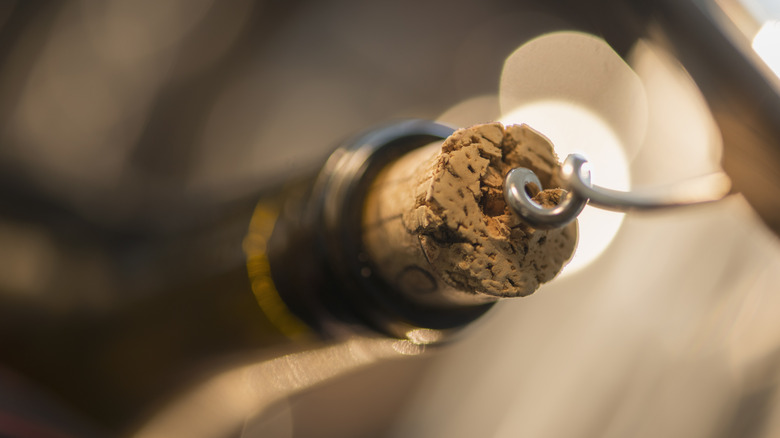Cork Taint: Why It Happens And What It Does To Your Wine's Flavor
Whether you're a seasoned sommelier or just dipping your toes in the world of wine, there's a good chance you've heard somebody complain about wine being "corked." It sounds odd at first, until you learn that "corked" isn't just a reference to the way the wine was sealed; it's actually a common way to refer to wine that has been spoiled by cork taint. Cork taint is one of the best-known forms of wine contamination, occurring when certain malodorous compounds in the wooden cork of a wine bottle seep into the wine itself.
Cork taint is not dangerous, but it's not pleasant either. Mild cases of cork taint can dull the flavor of wine, and more serious cases can impart a musty or mildewy aroma that spoils the whole bottle. The most troublesome part of the problem is that cork taint can affect almost any wine. There's a widespread belief that the cheapest wines are more likely to be corked, but that's a myth, and vigilance is required for every bottle of wine.
Corked wine is a frequent subject of conversation amongst wine enthusiasts, but it can also lead to confusion. Many end up questioning whether the glass they're sipping on has been affected by cork taint, or whether they simply dislike the particular wine in question. Recognizing when you're dealing with cork taint and what to do about it involves knowing a bit about the science behind the problem.
The cause of cork taint
Cork taint can be attributed to a variety of chemicals, but the most common cause is a compound called 2,4,6-trichloroanisole. That's quite a mouthful, so it's usually referred to as TCA, and it is sometimes found in tree bark, which wine corks happen to be made from. To be more specific, TCA can form when fungi, mold, and bacteria that are naturally present in trees come into contact with certain chemicals found in fungicides and insecticides, which stay in the soil long after being used.
TCA can also form when bleach comes in contact with wood. Consequently, cleaning products used in wineries can cause TCA to form in wine barrels or other parts of the facility. This means that even wines in screw-top bottles can suffer from cork taint, although it is rare.
Even though wine has been part of the human diet for millennia (the world's oldest winery has been operating since 862 AD), complaints about cork taint did not appear in records until the early 1900s. This can point to humans' role in causing cork taint through the increased use of pesticides and harsh cleaning products. Estimates vary, but it's thought that cork taint affects somewhere between two and seven percent of wine globally.
How to detect corked wine
Cork taint is rare in the grand scheme of things, but if you enjoy wine regularly, there is a good chance that you'll encounter a corked bottle eventually. To determine if your wine has suffered from cork taint, give it a whiff. Sensitivity to TCA varies from person to person, but if it is present in significant enough quantities, the wine will take on an unpleasant smell, which people often liken to wet cardboard or a wet dog. Its effect on how the wine tastes is more subtle because cork taint dulls your perception of flavor, making things bland. As a general rule, if you suspect that a wine might be corked, it probably is.
Unfortunately, there is no way to get rid of cork taint once it has infected a bottle of wine. If you're dining out, it's perfectly appropriate to send a bottle of wine back if you discover it's been corked. If the bottle is from your own personal collection, it will unfortunately be a loss. You can try to lessen the effects by giving the wine a chance to aerate. Use a wine aerator or pour it into a decanter. If aerating the wine doesn't help the issue, then it's safe to assume the bottle is corked and must be sacrificed.


